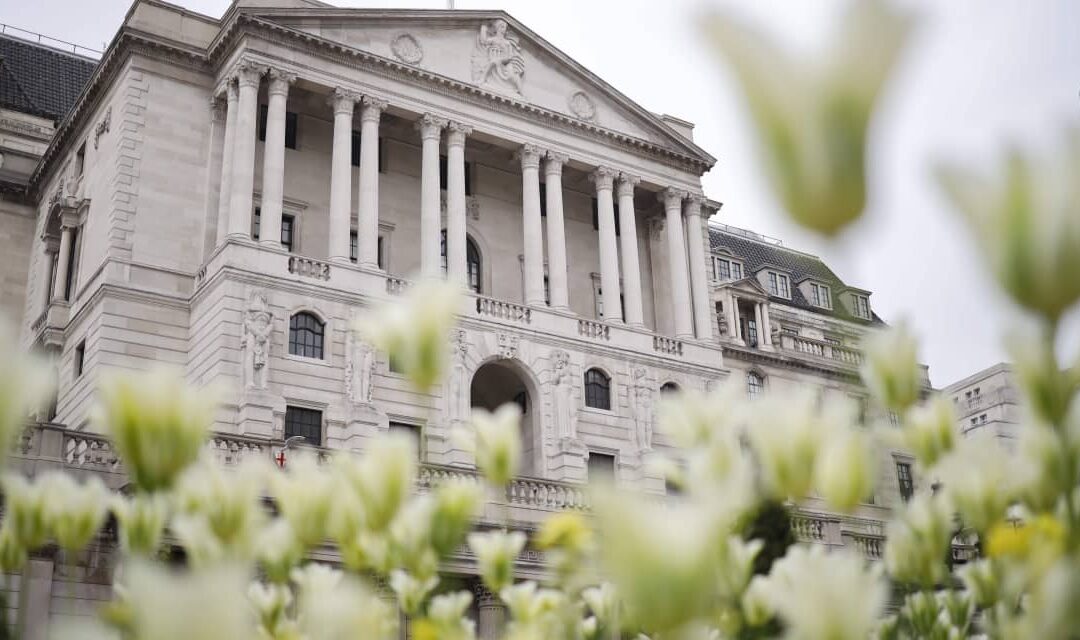New data showing an unexpected downturn in the U.K. economy is set to pile pressure on the Bank of England to lower interest rates next year, with money markets now pricing in 100 basis points of cuts for 2024.
Data released Wednesday showed an unexpected downturn in Britain’s economy, with gross domestic product falling 0.3% in October, against expectations for it to steady after a 0.2% rise in September.
Traders ramped up rate-cut expectations shortly afterwards, with the pound
GBPUSD,
dropping 0.2% against the dollar and gilt yields
BX:TMBMKGB-10Y
falling.
“Three quarter-point cuts were already factored in, but now there is an 85% probability of a fourth cut. The first cut is seen around June but could come sooner if inflation weakens sharply in the next few months,” said Fawad Razaqzada, market analyst at City Index and FOREX.com, in a note to clients.
“Prices could fall back rapidly due to the fact the economy is very soft with subdued activity across the key sectors. The bigger-than-expected 0.3% drop in monthly GDP and 0.5% fall in construction output we saw earlier today suggests the BoE’s tight policy is choking the economy,” he added.
ING economist James Smith noted “the amount of rate cuts priced in for next year has gone up by about 15 basis points since the start of the week” following the publication of data showing weaker-than-expected wage growth and the GDP contraction.
The Bank of England will hold its last policy meeting of the year on Thursday, where it is expected to vote 6-3 in favor of keeping interest rates steady at 5.25%. With chances of a cut at “approximately zero,” the central bank is seen holding off until key metrics, including wage growth start to fall.
The growth slowdown was driven by contractions in all three major segments of the U.K.’s economy, including a 0.2% contraction in the country’s services sector which accounts for 79% of U.K. GDP.
In October, U.K. manufacturing output also fell 0.8% following flat growth in September while construction output dropped 0.5% after posting an 0.4% uptick the previous month. The Office for National Statistics noted that unusually wet weather could be partly responsible for the dip in GDP.
Wage growth has also started to slow, according to data published on Tuesday, but the U.K.’s jobs market has remained resilient with unemployment still at low levels of just 4.2%.
Analysts said the BoE is determined to get inflation down, despite the positive signals, as wage growth and inflation remain high. But if core inflation, which currently sits at rates of 5.6%, drops to around 4% then the first cut could arrive by summer with more easing to follow, they say.
“Inflation and wage growth remain decidedly perky versus targets and long-term averages despite falling wholesale energy prices and fewer jobs vacancies,” David Roberts, head of fixed income at Nedgroup Investments said.
BoE governor Andrew Bailey has previously signaled he intends to continue pushing down inflation, despite positive signs that price growth has started to slow, with data showing inflation fell from 6.7% in September to 4.7% the following month.
Speaking to the Newcastle Chronicle in November, Bailey said it was “too soon” to talk about the possibility of interest rate cuts in “anything like the foreseeable future.”
“I recognize higher interest rates do have effects. They do have effects on mortgage costs, and they also have an effect on rental costs because they feed through. What I would say, to be honest, is that if we don’t get inflation down, it gets worse,” Bailey said.
Roberts said the BoE will likely seek to temper enthusiasm around the possibility of cuts, after several members of the MPC raised concerns at its last meeting that the pace at which market conditions have started to ease “risked prolonging inflation.”
Based on the Sterling Overnight Index Average (SONIA), the interest rate applied to bank transactions in the U.K., traders were on Wednesday forecasting rates around 4.28% by the end of next year from 5.25% currently.
Looking ahead, the BoE is likely to hold those rates high for longer than either the U.S. Federal Reserve or the European Central Bank as the country faces higher levels of inflation than either of those economies, said Jamie Dutta, market analyst at Vantage.
Dutta noted the BoE’s rate cuts could be sharper than introduced by either the Fed or the ECB if core inflation in the U.K. economy starts to fall significantly by the summer of next year.
ING economist JamSmith said he now expects the BoE will make 100 basis points of cuts in 2024, starting in August, alongside a further 100 basis points in 2025.
Morgan Stanley’s analysts are currently forecasting the ECB will make two 25 basis point cuts in June and September 2024 ahead of a series of sharper 50 basis point cuts in December 2024 and March 2025.








